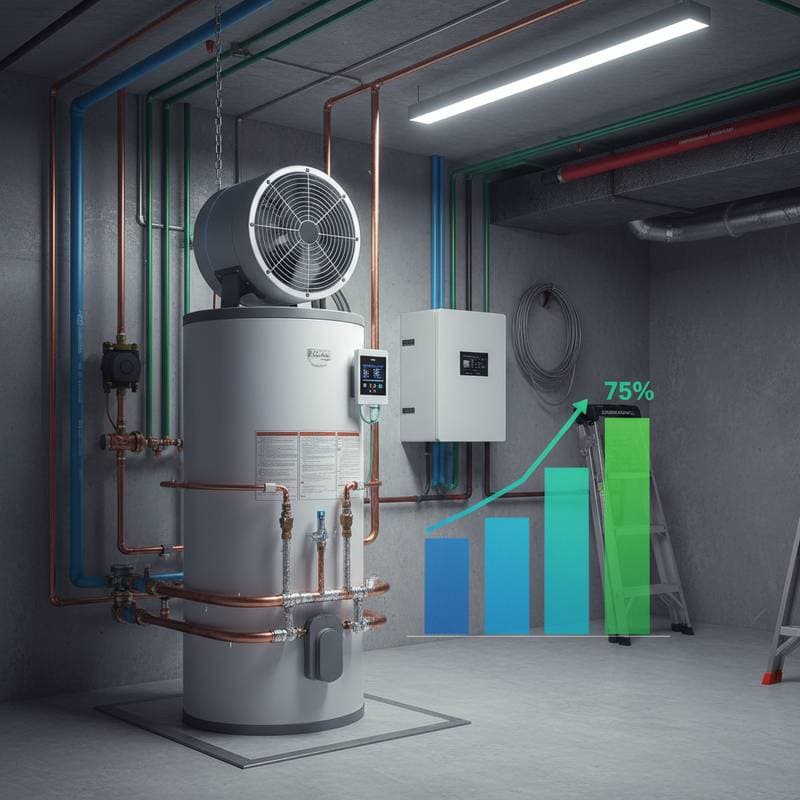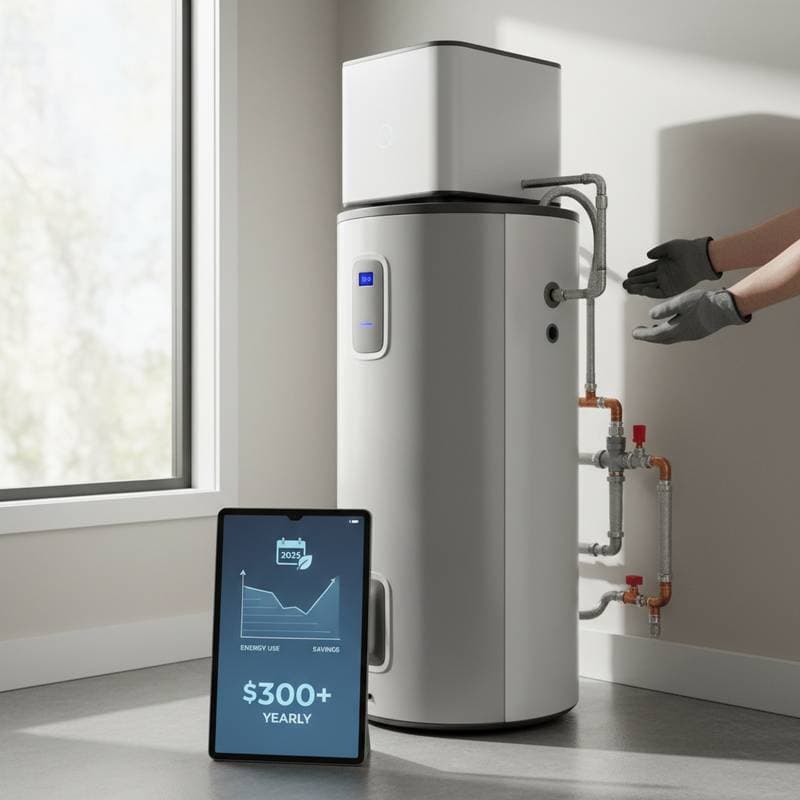Understanding Hybrid Heat Pumps and Their 52% Bill Reduction Potential
Winter heating costs concern many homeowners as temperatures drop. Hybrid heat pumps present an efficient solution to maintain warmth while minimizing expenses. These systems integrate electric and gas heating to achieve up to 52% savings on winter bills, delivering reliable performance across varying conditions. The following sections detail their mechanics, financial advantages, and suitability for different homes.
Defining the Hybrid Heat Pump System
A hybrid heat pump, or dual-fuel system, merges electric heat pump technology with a gas or propane furnace into a single unit. The electric component operates effectively in mild to moderate cold, extracting heat from outdoor air and transferring it indoors. When outdoor temperatures fall below an efficiency threshold, the system shifts to the furnace for robust heating.
An integrated thermostat oversees this transition by tracking ambient conditions and energy performance metrics. This automation ensures the most suitable heat source activates at any given time. Homeowners benefit from furnace-level comfort paired with heat pump efficiency, avoiding the limitations of standalone systems.
Mechanisms Behind Cost Savings in Hybrid Systems
Hybrid heat pumps lower heating expenses significantly, particularly in areas with inconsistent winter weather. Their design optimizes energy use through precise fuel selection. Consider these key savings drivers:
-
Intelligent Energy Selection
The system prioritizes the cheaper or more efficient fuel based on real-time data. Electricity powers the heat pump during favorable conditions or lower rates, while the furnace engages for extreme cold or advantageous gas pricing. -
Minimized Fuel Usage
The furnace activates only when essential, conserving gas or propane reserves. This approach not only trims utility statements but also prolongs furnace durability by limiting operational cycles. -
Decreased Maintenance Expenses
Workload distribution between components reduces mechanical stress. Consequently, repair frequency diminishes, and overall system longevity increases. -
Superior Efficiency Metrics
These units often achieve elevated Seasonal Energy Efficiency Ratios (SEER) and Heating Seasonal Performance Factors (HSPF). Higher values indicate better energy-to-heat conversion, resulting in reduced waste and sustained savings.
Indicators for Upgrading to a Hybrid Heat Pump
Current heating setups may signal the need for a hybrid system if performance falters or costs escalate. Evaluate these common indicators:
- The furnace operates continuously, yet indoor temperatures remain inconsistent.
- Electricity or gas bills surge during winter periods.
- Residence experiences variable cold spells rather than steady extremes.
- Access to both electrical service and natural gas or propane lines exists.
- Interest in lowering environmental impact persists alongside comfort priorities.
Matching several of these criteria suggests a hybrid heat pump could optimize home heating.
Variables Influencing Hybrid Heat Pump Expenses
Installation and system costs fluctuate according to multiple elements. Awareness of these factors aids in accurate financial planning, though specifics vary by region and provider.
-
Capacity and Scale Requirements
Larger residences demand greater output units. Technicians perform load assessments, factoring in insulation quality, window efficiency, and total area, to determine appropriate sizing. -
Performance Specifications
Units with advanced SEER and HSPF levels involve higher initial investment. Long-term energy reductions often offset this premium through decreased operational costs. -
Manufacturer and Configuration Choices
Reputable brands provide extended warranties and sophisticated controls. Although pricier, their dependability justifies the expenditure for many users. -
Setup Intricacies
Modifications to existing ducts or electrical infrastructure elevate labor charges. Expert installation remains vital for operational integrity and compliance. -
Regional Weather Patterns
Milder climates maximize heat pump utilization for substantial gains. Even harsher environments yield benefits via targeted furnace deployment.
Comparing Hybrid Heat Pumps to Conventional Options
Assessing hybrid systems against traditional alternatives highlights their versatility. The table below summarizes distinctions:
- Standalone Electric Heat Pump: Excels in temperate zones but loses effectiveness in subfreezing conditions.
- Standalone Gas Furnace: Delivers intense heat yet consumes more fuel and generates elevated emissions.
- Hybrid Heat Pump: Merges strengths for adaptive operation, ensuring comfort while curbing expenses through seamless integration.
This combination eliminates the drawbacks of single-source systems, providing balanced, efficient heating without redundant equipment.
Overview of the Hybrid Heat Pump Installation
Preparing for installation involves understanding the sequential steps. Professional oversight ensures seamless integration and peak performance.
-
Initial Assessment
An HVAC specialist examines existing infrastructure, including ducts and wiring, to confirm compatibility and pinpoint necessary adjustments. -
Equipment Selection
Guidance from the technician aligns choices with heating demands, efficiency targets, and fiscal constraints. -
On-Site Implementation
Legacy components receive removal, followed by hybrid unit placement, refrigerant connections, control wiring, and duct sealing. -
Verification and Adjustment
Comprehensive testing validates functionality, airflow balance, and thermostat configuration for optimal results. -
Ongoing Care Instructions
Owners obtain protocols for routine tasks like filter replacement and annual professional inspections.
Engage certified professionals exclusively, as substandard work compromises safety, efficiency, and coverage terms.
Frequently Asked Questions
How does a hybrid heat pump determine the switch between gas and electric modes?
A built-in thermostat evaluates outdoor temperatures and efficiency thresholds. The system defaults to the furnace when the heat pump's performance declines in colder air, preserving indoor comfort without manual intervention.
Are hybrid heat pumps suitable for extremely cold regions?
They adapt well to varied winters, with the furnace dominating in severe cold. The heat pump supplements during milder intervals, curbing overall fuel needs even in challenging climates.
What is the expected lifespan of a hybrid heat pump?
Regular upkeep enables 15 to 20 years of reliable service. Duration hinges on operational intensity, setup precision, and consistent maintenance schedules.
Is self-installation of a hybrid heat pump feasible?
No, professional installation proves essential due to complex electrical, refrigerant, and safety requirements. Attempting DIY work risks inefficiency, hazards, and warranty invalidation.
How frequently should a hybrid heat pump receive servicing?
Annual professional tune-ups recommended, alongside quarterly filter checks and seasonal inspections. This regimen sustains efficiency and preempts potential issues.
Taking Action on Your Heating Upgrade
Hybrid heat pumps provide adaptive heating that aligns with weather fluctuations and utility rates, fostering substantial savings and comfort. Consult a qualified HVAC expert to assess compatibility and initiate the process toward enhanced home efficiency.





